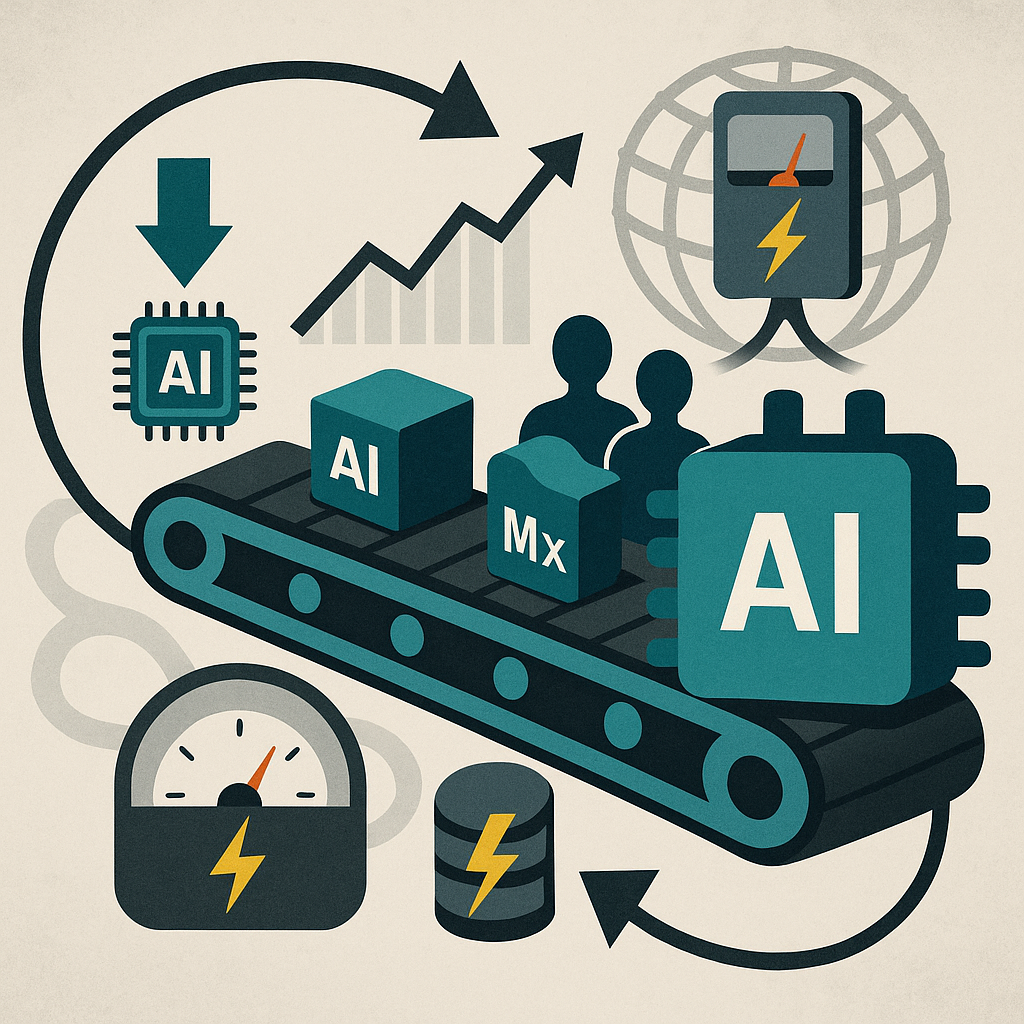“Hey ChatGPT, write me an email.”
Sounds harmless, right?
What if I told you that simple request just consumed a bottle of water that could have quenched a child’s thirst?
The Dirty Secret Behind Your AI Assistant
I remember the first time I realized what was happening behind the scenes of our AI revolution. I was going through some articles mentioning millions of gallons of water being pumped through cooling systems just to keep the AI operations running.
That's when it hit me: every seemingly weightless digital interaction has a very physical cost!!!

While we marvel at ChatGPT writing essays and DALL-E creating stunning artwork in seconds, most of us never consider in depth what powers these digital miracles. The uncomfortable truth? Behind every AI query lies a resource-hungry infrastructure that's rapidly becoming one of our planet's most alarming environmental challenges.
A bombshell dropped recently when Google released its environmental report: the tech giant's carbon emissions skyrocketed by an eye-popping 48% in a single year, primarily due to AI operations. Even worse, they replenished only 18% of the water they consumed—a sobering reality check when compared to their ambitious 120% water replenishment goal set for 2030.
And this isn't just Google's problem—it's an industry-wide crisis unfolding in plain sight.
Power Hungry: AI's Insatiable Appetite for Energy
Let me put this in perspective for you. The energy consumption of AI has reached levels that would make even the most hardened sustainability expert gasp:
⚡ MIND-BLOWING ENERGY FACTS | WHAT IT ACTUALLY MEANS |
1,050 terawatts | By 2026, data centers will consume more electricity than entire countries like Russia. Imagine your Instagram reels and chatbot queries collectively consuming more power than 145 million people. |
12% | By 2028, data centers could devour 12% of all US electricity. That's roughly equivalent to powering every home in California, Texas, and New York—combined. |
1,287 MWh | Training a single AI model like GPT-3 consumes enough electricity to power 120 average US homes for a year. Your helpful AI assistant required the same energy as an entire neighborhood just to learn how to chat. |
7-8× more | AI training isn't just resource-intensive—it's resource-ravenous, consuming up to 8 times more energy than standard computing. That efficient-looking chatbot is actually an energy hog behind the scenes. |
48% | Google's carbon emissions jumped by nearly half in just one year due to AI. That's like someone who normally takes three flights annually suddenly taking 77 flights in a year. |
When I speak with clients about implementing AI solutions, these numbers often shock them into silence. The electricity needed to train a single large language model could power a small town for several days. That's before we even consider the ongoing energy needed every time someone asks an AI to write a poem or create an image.
In real-world terms, while you're reading this article, data centers around the world are drawing more power than some countries—just to keep our digital lives humming along. And AI is rapidly becoming the most power-hungry component of that digital ecosystem.
The Water Crisis No One's Talking About
Energy consumption gets plenty of attention, but here's whats more alarming: AI's insatiable thirst for water.
Recently, I analyzed a comprehensive report on data center water usage in the Southwest. The findings were alarming: massive data centers are operating in regions experiencing the worst drought in 1,200 years. The report included testimonials from community leaders expressing frustration: "They're getting water allocations while our residential wells are running dry. How is this acceptable?"
The numbers tell a devastating story:
💧 WATER REALITY CHECK | WHY YOU SHOULD BE CONCERNED |
550,000 gallons | A single Google data center consumes enough water daily to fill an Olympic swimming pool—and serve the needs of 2,200 American households. That's one data center, one day. |
4.2-6.6 billion m³ | By 2027, AI could be gulping down as much water annually as 4-6 Denmarks combined. We're creating artificial intelligence by draining very real lakes and aquifers. |
82% | The gap between Google's actual water replenishment and their goal reveals how even the most well-intentioned tech companies are struggling to offset their impact. |
1 bottle | Every time you ask ChatGPT to write you an email, the process consumes enough water to fill a standard kitchen water bottle. Think about that next time you're using AI for something trivial. |
Technical literature and industry reports have thoroughly documented how these systems work: The servers running complex AI calculations generate enormous heat—heat that's primarily managed by water cooling systems that convert freshwater into evaporated vapor.
It's a sobering thought: in a world where nearly 2 billion people lack access to safe drinking water, we're evaporating massive quantities of this precious resource just so AI can generate memes and write our emails.
The Environmental Justice Question: Who's Paying the Price?

Something troubling emerged from my research into data center placements and resource allocation: a pattern of environmental injustice that demands our attention as technology professionals.
When analyzing documented case studies in the American Southwest, I found consistent evidence of concerning disparities. In communities already rationing water due to severe drought, data centers were receiving generous water allocations. In one documented instance, residents faced fines for watering gardens while trucks delivered thousands of gallons to nearby computing facilities.
This pattern isn't random—it's systematic. The environmental burden of our AI revolution isn't shared equally. Technical documentation and industry reports confirm that tech companies, searching for affordable locations for their massive data centers, strategically target regions with lower costs—typically areas already facing resource constraints.
Consider these troubling patterns revealed in recent studies:
- Microsoft, Meta, and Google have all established major data centers in drought-prone regions like Arizona and Texas
- These facilities receive preferential water allocations that can supersede the needs of local communities
- Many residents don't even realize why their water bills are rising or why restrictions are tightening
The international picture is even more disturbing according to global water usage reports. Tech giants are aggressively building data centers in developing regions across Latin America and parts of Africa, where environmental regulations may be less stringent and resources cheaper. Communities already struggling with water access suddenly find themselves competing with power-hungry data centers serving users thousands of miles away.
This raises questions that we as technology leaders and project managers must confront head-on:
- Who should have priority access to water during shortages: local communities or data centers powering global AI services?
- Should companies building data centers be required to invest in local water infrastructure to offset their impact?
- How can we ensure the environmental burdens of AI development don't disproportionately affect disadvantaged communities?
These aren't just abstract ethical questions—they're urgent project management considerations that demand our immediate attention.
The Hard Truth: Why Getting More Efficient Makes Everything Worse

Here's an inconvenient reality I've observed across dozens of AI implementations: efficiency improvements almost always lead to increased consumption, not conservation.
It's like a rebound effect. You make the freeway wider, people use less fuel because traffic moves faster, but then you get more cars coming in. You get more fuel consumption than before.
I've seen this paradox play out repeatedly in today's environment:
- Company A implemented a new, 30% more efficient AI model, then promptly increased their query volume by 50%
- Client B upgraded to energy-efficient hardware, then expanded their AI applications into three new business areas
- Organization C optimized their algorithms to use less computing power, then trained models twice as large
The statistics confirm this troubling trend. Between 2022 and 2023, North American data centers nearly doubled their power consumption from 2,688 megawatts to 5,341 megawatts—despite significant efficiency improvements during the same period.
I call this "the efficiency trap," and it's the most pernicious challenge we face in sustainable AI implementation. Each technological improvement that should reduce resource consumption instead enables more ambitious AI applications, ultimately increasing our overall environmental footprint.
Breaking this cycle requires a fundamentally different approach to AI project management—one that incorporates absolute resource caps, not just efficiency metrics.
Drawing the Line: A Project Management Framework for AI Resource Decisions
As project managers, we're uniquely positioned to guide organizations through complex decision-making processes. When it comes to AI implementation, I've developed a structured evaluation framework to determine when AI's benefits justify its environmental costs.
The AI Value-to-Impact Assessment Matrix
This framework helps project teams evaluate AI initiatives across two critical dimensions:
- Value Creation: The business, social, and operational benefits generated
- Environmental Impact: The resource consumption and ecological footprint
The assessment follows a structured project management approach:
Step | Action |
1️⃣ | Resource Impact Analysis – Water, energy, carbon, location |
2️⃣ | Value Generation Assessment – Business, efficiency, social, sustainability |
3️⃣ | Alternatives Evaluation – Simpler AI? Smaller models? Manual options? |
4️⃣ | Decision Matrix – Map on Value vs. Impact to decide execution |
🎯 Download the Framework as PDF
Through this systematic project management approach, organizations can objectively determine which AI applications deliver sufficient value to justify their environmental footprint.
Real-World Application Examples
💡High Value, Lower Impact (Recommended)
- Optimizing energy grid operations to reduce overall consumption
- Improving agricultural irrigation systems to conserve water
- Enhancing transportation logistics to reduce emissions
⚠️Low Value, High Impact (Avoid)
- Using resource-intensive AI for trivial content generation
- Implementing AI chatbots for simple customer interactions that could be handled through other means
- Developing image generation systems for purely entertainment purposes
The key to responsible AI implementation lies in this systematic evaluation process—a core project management discipline that must be applied rigorously to every AI initiative.
Actionable Strategies for Sustainable AI Deployment
Beyond the project management framework, several practical approaches can mitigate AI's environmental impact:
1. Technological Solutions ✅
- Specialized AI hardware designed specifically for energy efficiency
- Alternative cooling technologies like liquid immersion cooling, which can reduce water usage by up to 90%
- Model optimization techniques like quantization and pruning that reduce computational requirements
- Renewable energy integration with energy storage solutions to power data centers
2. Policy and Corporate Accountability 🏛️
- Standardized reporting requirements for water and energy usage by AI systems
- Water-neutral policies requiring tech companies to offset their water consumption
- Carbon pricing mechanisms that incorporate the true environmental cost of AI operations
- Location-based approvals for new data centers that consider regional water stress
♻️ AI as Part of the Solution: The Dual Nature of Technology
While highlighting AI's resource challenges, we must also acknowledge its potential as a sustainability tool. AI offers powerful capabilities for environmental protection:
- Optimizing agricultural irrigation to reduce water waste
- Improving energy grid efficiency to minimize losses
- Enhancing waste management systems through smart sorting
- Detecting pollution in water systems before it reaches dangerous levels
- Monitoring deforestation and other environmental changes with satellite imagery
The key is ensuring that these sustainability benefits outweigh the resource costs of the AI systems themselves—a calculation that requires honest assessment and careful planning.
🧭 The Leadership We Need Now
As project managers, we don't just implement technology—we shape how it impacts our world. The future of sustainable AI depends on professionals who refuse to separate technical implementation from environmental responsibility.
We stand at a defining crossroads where our choices will determine whether AI becomes an environmental liability or a catalyst for sustainable progress. The technologies we're building today will either drain our planet's resources or help us protect them.
The difference always comes down to leadership—professionals who have the courage to ask hard questions, make tough choices, and redefine success to include environmental stewardship alongside business metrics.
The path forward isn't abandoning AI innovation but pursuing it with a deep commitment to sustainability. This means incorporating environmental considerations into every phase of the project lifecycle, from initial conception through deployment and beyond.
The good news? When we get this right, the results are transformative. I've worked with teams that reduced their AI's environmental footprint by over 60% while delivering better business outcomes. The synergy between sustainability and performance isn't just possible—it's the only viable path forward.
- What sustainability challenges are you facing in your AI implementations?
- What's your perspective on AI's environmental impact?
- Are the benefits worth the resource costs?
Share your experiences in the comments below, and subscribe to our newsletter for more insights on sustainable technology management. Let's learn from each other as we navigate this critical challenge together.
FAQs
Yes, surprisingly so. Every time you send a prompt to an AI like ChatGPT, it taps into large data centers that require immense electricity and water to cool servers. A single query can consume the equivalent of a small bottle of water—multiplied by billions of queries daily.
Most large-scale AI servers use water-based cooling systems to prevent overheating. These systems evaporate freshwater into vapor, which is then lost to the atmosphere—creating a huge and often overlooked environmental footprint.
Yes—and that’s the paradox. AI can optimize energy grids, detect pollution, improve crop yields, and more. However, if not implemented responsibly, its resource consumption can outweigh the benefits. That’s why sustainable project management practices are critical.
It comes down to cost. Land, water rights, and energy may be cheaper in rural or underserved regions. Unfortunately, this often means local communities must compete with tech giants for basic resources like clean water—raising serious environmental justice issues.
Yes, they can. Some effective strategies include:
- Using renewable energy for data centers
- Switching to liquid immersion cooling (uses less water)
- Training smaller, optimized AI models
- Deploying AI only when its value justifies its impact
- Limit trivial queries that don’t create value
- Choose platforms powered by renewable energy
- Encourage sustainability audits in your organization’s AI use
- Educate your teams and stakeholders on the true cost of AI
It’s a project management tool I developed to help evaluate whether an AI initiative justifies its environmental cost. You can download it here and start applying it in your AI planning process today.
Sources and Further Reading
- International Energy Agency (IEA). (2024). World Energy Outlook 2024.
- Lawrence Berkeley National Laboratory. (2024). United States Data Center Energy Usage Report.
- Yale Environment 360. (2024). "As Use of A.I. Soars, So Does the Energy and Water It Requires".
- Ren, S., University of California, Riverside. (2024). "The Water Footprint of AI: Challenges and Opportunities".
- Google. (2024, July). Environmental Report 2024.
- MIT News. (2025). "Explained: Generative AI's environmental impact".
- The Washington Post. (2024, October). "How much energy can AI use? Breaking down the toll of each ChatGPT query".
- OECD.AI. (2025, February). "The hidden cost of AI: Unpacking its energy and water footprint".
- University of Illinois. (2024). "AI's Challenging Waters: Environmental and Social Implications".
- Planet Detroit. (2024, October). "AI's environmental impact: Energy consumption and water use".